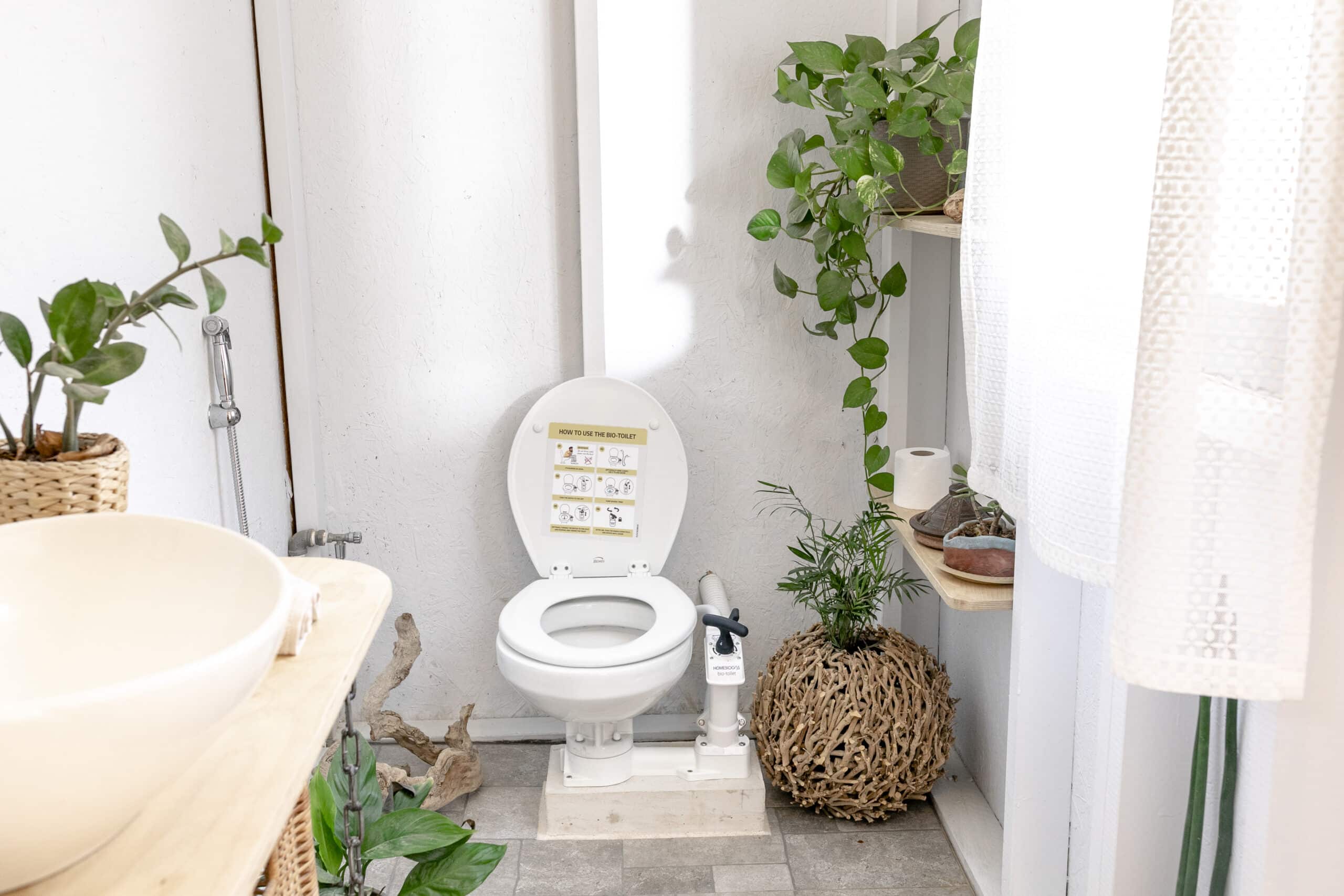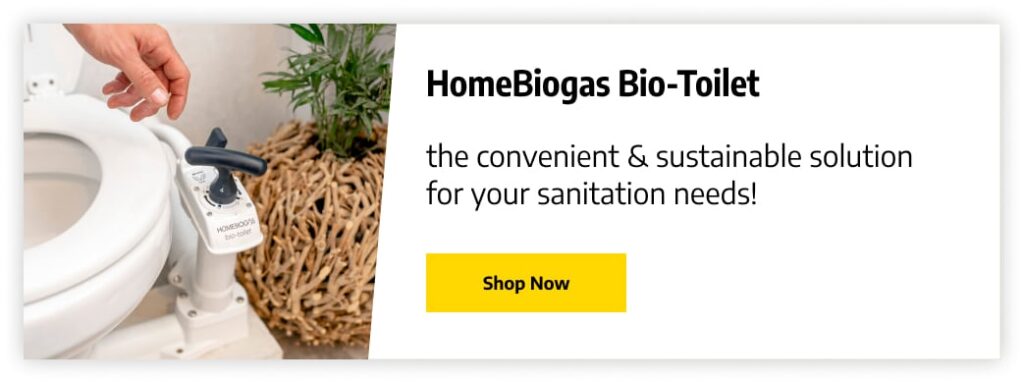
What is an incineration toilet?
An incineration toilet is a system that burns biological waste at high temperatures. The process turns human waste into small amounts of ash—depending on the product you choose, it can mean one teacup of ash for a family of four per week.
The system is popular because it enables users to eliminate all the waste without worrying about storage, transportation, or disposal. Also, it functions without water and doesn’t need a drainage solution.
Incineration toilets can be electric or gas-powered.
How does an incineration toilet work?
An incinerator toilet comes with a sealed incineration chamber, where waste is treated at high temperatures to dry the organic matter first and then burn the remains. Vapor and combustion gases are vented through a ventilation pipe. This enclosed space makes the system an odorless and highly hygienic waste management solution, even for off-grid houses.
Incineration toilets need electric power or natural or propane gas to produce sterile ashes, as the temperatures necessary for completing this process are between 970 and 1400°F (500-750°C). In some countries and states, you might need a certified venting system that protects you, your property, and the people who live or visit.

How an electric incineration toilet works
Electric incineration toilets are made of stainless steel and usually look like traditional toilets. When you use it, you need to coat it with a liner or waste paper to keep the bowl clean and quickly move the waste down to the incineration chamber. Usually, users must burn the waste every two to four “flushes.”
The entire process is relatively short—between one to three hours, and the remainings can be discarded into the environment and used as an organic fertilizer.
An electric incinerator toilet comes with filters to help manage odors, an electric fan, and an exhaust vent to eliminate combustion gases and control the chamber’s high temperature.
The toilet won’t work during an outage.
How a gas-powered incineration toilet works
Gas-powered incineration toilets are less practical as they require a natural gas or propane source. You might have to put the system through regular inspections for health and safety reasons.
A small system will look like the electric toilet, but these can also take an industrial form—more similar to a portable outhouse. Depending on the size of the system and how large the incineration chamber is, the process can last up to 3-4 hours.
Does “incineration toilet” actually means electric toilet?
Not necessarily. All incineration toilets require power to function properly—even the gas-powered systems need electricity for the fan. However, not all electric toilets have an incinerator incorporated.
Do incineration toilets require maintenance?
Incineration toilets require regular cleaning of the bowl, just like any other waste management system. Periodically, you’ll also have to empty and clean the ash container.
Annual cleaning and maintenance are needed for the exhaust pipe and venting system to eliminate dust and ash particles, which might stop the system from functioning correctly.
The difference between incineration and other bio-toilets
Incineration and other bio-toilets are similar and replicate a traditional flushing toilet. So, aesthetically, you shouldn’t expect significant differences. And in both cases, you’re looking at similar results: you turn the waste into something useful with a relatively small impact on the environment.
On the other hand, the processes that make these systems work are very different.
Incineration is clean and fast. Everything happens automatically—you press a button, and the system burns the waste with no further assistance from you. The incineration toilet accelerates all the processes to eliminate the waste in as little as an hour with small amounts of residues that you need to remove regularly.
Most bio-toilets compost the waste and turn it into organic fertilizer, which is a long process that requires space for storage, a way to dispose of the fertilizer, and sometimes even waste handling. Depending on the product you opt for, it can quickly become a daily chore for you or someone in your family.
Power consumption is the other significant difference between incineration and compost toilets. However, the overall consumption and impact on the environment on an electric incineration toilet are still smaller than what we need to clean and recycle wastewater.

Advantages & disadvantages of incineration toilets
Advantages:
- Water-saving. American households flush 24% of the water they consume each day. Incineration toilets can save water and the resources that would go into recycling wastewater.
- Low maintenance. You won’t have to deal with pipes, leaks, or composters.
- Environment friendly, especially when you use green energy to power it.
- Easy to use. Everything happens automatically, and you only need to manage ash disposal, which is more accessible than handling compost.
- No odors. Thanks to the electric fan and the venting system, the incineration process is fast and odorless when everything functions correctly.
Disadvantages:
- Installation. Multiple elements might require professional assistance, such as installing a venting system that observes health and safety rules and connecting your toilet to a gas pipe.
- Power consumption, especially if you opt for an electric incineration toilet.
- High upfront costs. These systems are significantly more expensive than other bio-toilets, and installation will add extra costs.
Where & how should an incineration toilet be installed?
Incineration toilets are best suited for off-grid properties where the water service isn’t available. However, you will need electrical service or solar panels to power the system—an electric incineration toilet can use up to 1.5-2 kilowatt-hours of electricity per cycle. In the case of gas-powered incineration toilets, you still need electricity to power the fan and a gas source, whether it’s permanent or mobile.
You can also use this system for construction sites, camps, cabins, or fishing shacks.
When installing the incineration toilet, you must follow the manufacturer’s instructions to the letter and, if possible, have professional assistance. Some states might also require an inspection of the venting system, as this pipe is essential to the toilet’s efficiency. Last but not least, for connecting the toilet to a permanent gas source, you might need a special permit, depending on where you live.
Where to buy a ready-made incineration toilet
This system is highly effective, but it can also be dangerous if even one of its elements doesn’t work correctly. So, you want to buy an incineration toilet from an approved, established manufacturer that understands the specific requirements the product must meet in your state.
Do your due diligence, read multiple product reviews online, and ensure the manufacturer can assist with installation and maintenance.
What the future holds for incinerating human waste
While burning human waste on a large scale doesn’t seem a sustainable solution, incineration toilets for domestic use might continue to be a reliable alternative to flushing toilets.
However, adoption at a large scale is not likely to happen due to the high upfront costs and energy consumption.
HomeBiogas alternatives
The HomeBiogas Toilet-Kit is not an incineration toilet, but it enables users to burn human waste after it turns it into biogas. The process takes longer, as bacteria need time to transform waste into fuel, but the benefits are significant.

This system is not a regular compost toilet, so you don’t have to handle the waste. The HomeBogas Toilet-Kit functions independently using anaerobic digestion to make fuel and transport it to the kitchen stove.
Instead of turning your waste into ash, you get to make reusable energy that can be used for cooking or heating, bringing you one step closer to a self-sustainable lifestyle.
Take a giant leap towards a self-sustainable lifestyle with three different sizes to suit any household. Embrace the future of waste management and unlock the power of HomeBogas Toilet-Kit today!

Conclusion
Incineration toilets are elegant alternatives to traditional toilets. These systems burn waste at high temperatures, and the ash resulting from the process can be discarded in the environment and used as organic fertilizer.
The downside is that this waste management system is expensive—the upfront costs are high, the installation might require professional assistance, and each burning cycle requires electric power. It’s best to opt for this solution after carefully considering its advantages and disadvantages.





